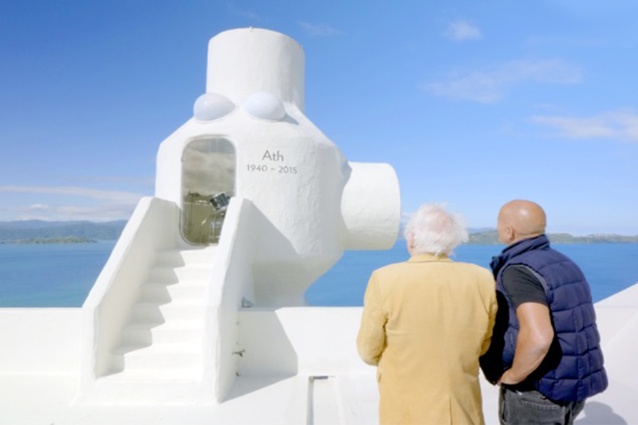Editorial: Chris Barton on Vive la différence
Matthew Ridge makes a quite good architecture show host. Yes, the blokey former rugby and league player and tabloid personality also known as ‘Ridgey,’ who, with his mate Marc Ellis, gave us such gems of TV lad culture as Matthew and Marc’s Rocky Road, Fresh-up in the Deep End plus the sports quiz Game of Two Halves.
In the new Prime TV and Neon series, Designing Dreams, the larrikin Ridge has been replaced by someone who wants to be taken seriously, but can’t help but pronounce one of the houses on the show as looking “MacDaddy”. His attempts to engage in the architecturespeak of his subjects are admirable: “It gives it a sense of bigness and openness and more space…” Not because Ridge is saying anything profound, but because he is genuinely determined to reveal what the architects he’s talking to are on about – not always an easy task. Ridge’s greatest asset is actively listening, staying out of the way. That makes room for the Aotearoa architects profiled – Pip Cheshire, Julie Stout, Nicholas Dalton, Roger Walker, Anna-Marie Chin and Michael O’Sullivan – to talk about what being an architect means to them.
In this sense, it’s an uncritical view but the intriguing selection of architects presents an informative and entertaining range of perspectives on just what architecture is – unlocked by having each architect discuss their three favourite Kiwi homes designed by others.
Famed Wellington architect Roger Walker kicks off the series with the proposition that architecture is about being different. He chose Sir Ian Athfield’s house in Khandallah, the legendary village tumbling down a hillside, as his first favourite because it was different. “It’s the joy of surprise,” says Walker. While “the terrible twins” of Wellington architecture have often been compared, Walker says the only similarity is that they “did enjoy upsetting people”. Athfield’s house still carries the wounds of being shot at.
The different approach to affordability is why Walker likes The Dogbox – “MacDaddy” – in Whanganui, designed and built by architectural graduates Tim Gittos, Ben Mitchell-Anyon and Sally Ogle. “Unusually,” says Ridge, “the internal stair takes you back outside.” Indeed, quite unusual to have the hallway outside on the wide verandah – compulsory indoor-outdoor flow worth a more critical look.
Walker’s final choice is Ken Crosson’s 2020 Home of the Year, Light Mine beach house at Kuāotunu on the Coromandel Peninsula. Walker chose it because it was… different. “He [Crosson] does different well.” But, once again, the pitfalls of different are highlighted. During construction, someone painted the words “ugly house, shouldn’t be here” across the site sign. For all his laid-back demeanour, Ridge digs into how, in architecture, passions run deep.
“You don’t do ordinary,” says Ridge. “I don’t think you need to do ordinary,” says Walker. With a celebrity host like Ridge, the show was never going to have much critical heft but as an evocation of what good architects generally do – the not ordinary, the different – it’s not a bad analysis and also gives Walker’s body of work its due.
You don’t need to do ordinary. The series offers a terrific range of contrasting modi operandi. Perhaps most arresting was that of Nicholas Dalton of TOA Architects. Discussing his third choice of favourite house – Tent House by Chris Tate on Waiheke Island, an asymmetric A-frame in the bush – Dalton describes architecture as an act of courage. “This is one of the bravest housesin the country. Just because, who does this? It’s not big, but it’s pure in its form. People either love it or they don’t and, for me, that’s kind of what top design is about. It sort of challenges your thinking.”
The Dalton episode is all about honouring Māori culture in architecture and the challenge of “how we fuse that old world with living today”. In doing so, Dalton sets out a richly layered whakapapa of architectural influences: from St Faith’s Anglican Church at Ōhinemutu in Rotorua, to the 1981 Ngamatea Homestead in Hawke’s Bay by pioneering Māori architect, the late John Scott, to the “celebration of entry into another realm” found at the 1992 Te Whare Wānanga o Awanuiārangi in Whakatāne by designTribe Architects, headed by Rau Hoskins.
But by far the most poignant is Dalton’s tribute to his architectural koro Rewi Thompson at the Wishart House, a holiday home at Ōmāpere on the Hokianga Harbour, designed by Thompson in 1996. “You don’t realise how much someone gives you till they’re not there any more. He just gave. He was just next level and I made the mistake of saying we’ll all fill his shoes. Someone said, ‘We’ll never do that’, but I’ll die trying.”
Anna-Marie Chin’s episode has a similar acknowledgment of childhood and other key influences, plus her dynamic ongoing “modern interpretation” of traditional gable forms in the “big gutsy” South Island landscapes. Then there’s the provocative Michael O’Sullivan: “A home has to be a beautiful piece of art, and it has to be provocative at every turn.” And Pip Cheshire on the space between: “It’s the space between buildings, and the transitions between inside and outside, from public space to private space. All of those things are the real meat of architecture.”
Julie Stout expands the possibilities of what architecture can be with a question: “How do you make things better?” Her answer is to protest. “You’ve got to speak up. As an architect, you have a responsibility to the heritage of your city.” She also gives a moving tribute to her partner, the late David Mitchell. “The most important thing for him was that architecture touched you emotionally.”
In its unlocking of wildly different views of what Aotearoa architecture can be, Designing Dreams is ultimately uplifting and inspiring.
Vive la différence and bring on the second series.










